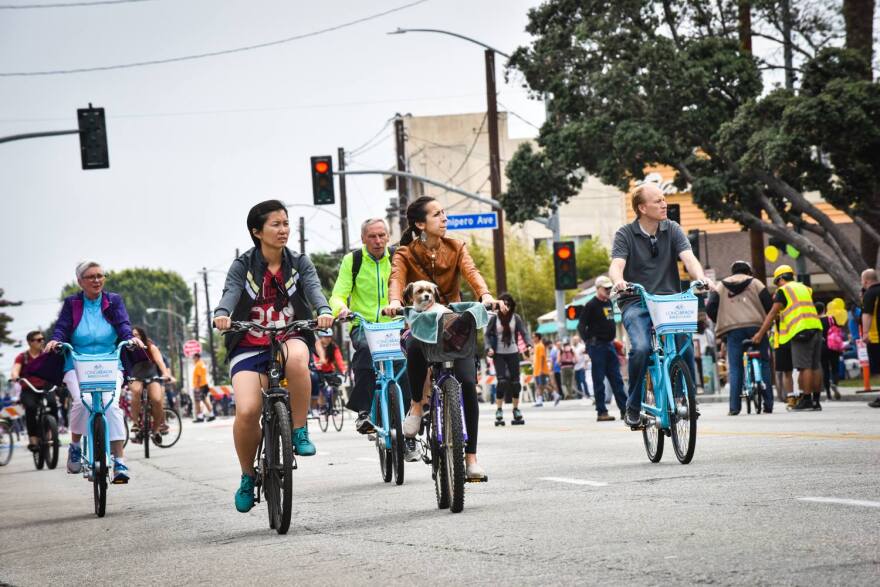With our free press under threat and federal funding for public media gone, your support matters more than ever. Help keep the LAist newsroom strong, become a monthly member or increase your support today.
LA counts bicyclists and pedestrians amid national slowdown in biking growth

The Los Angeles County Bicycle Coalition and Los Angeles Walks are holding a bike and pedestrian count this month to measure the progress in local efforts to get more people to bike and walk.
Cities like L.A. have pushed for more biking and walking as an alternative to driving, citing statistics that show that half of all trips taken in L.A. are fewer than three miles and emissions from cars and trucks are the biggest contributor of greenhouse gases in California.
The count has been taken every other year since 2009 to provide local agencies and officials with information on where and how frequently people walk and bike around Los Angeles. The data helps inform officials' decisions on infrastructure, such as where crosswalks or bike lanes may be needed, and measures how well such infrastructure is being used.
"This can tell us where folks feel safe to ride and walk, and help us advocate to LADOT (L.A. Department of Transportation) and Metro (Metropolitan Transportation Authority) for installing the types of infrastructure that can have a demonstrable impact on keeping our streets safer for all who use them," said Erik Jansen, executive director of the L.A. County Bicycle Coalition.
The counts began eight years ago, coinciding with a surge in interest among the public and local governments in biking. From 2009 to 2013, the city of L.A. aggressively added miles of bike lanes.
But that progress has slowed in recent years; L.A. went from a high of 101 new miles installed in 2013 to just 11 miles in 2015.
The counts have tracked steady increases in the number of people biking in L.A. until 2015, when the number fell by 9 percent, a phenomenon that has been seen in other major U.S. cities as well.
"The more recent trend shows a leveling off, and in some cities a falling trend in cycling," said Ralph Buehler, associate professor of urban affairs at Virginia Tech who studies biking and transportation.
He pointed to recent census data from the American Community Survey that show flattening or declines in biking to work in cities like New York, Chicago and Philadelphia.
In Los Angeles, the share of people biking to work grew from 0.6 percent in 2008 to 1.3 percent in 2014, according to census numbers. In 2016 it dropped down to 1.1 percent of commuting trips in L.A.
Buehler said the decreases in cycling correspond to lower gas prices, a better economy and more driving during the same period. But he also thinks L.A. and the other cities may have hit a plateau in their efforts to attract cyclists.
"Many cities have bike paths, lanes or cycle tracks, but not complete networks," he said.
He theorizes those initial efforts succeeded in increasing the ranks of hardcore, more aggressive cyclists, but haven't been enough to convert average people to give up their cars and feel comfortable biking on the streets.
It would take more safety measures like protected bike lanes that connect throughout the city, he said. The 2015 L.A. bike and pedestrian count showed the drop in cycling was not universal. There was a significant increase in cycling on roads that had new bike lanes.
"It has to be safe, and it has to feel safe, and in many places it just doesn't yet," Buehler said.
L.A. has a plan to add hundreds of miles of bike lanes as part of its long-range Mobility Plan 2035, but such efforts have met with stiff resistance in some neighborhoods because they would reduce space for cars.







